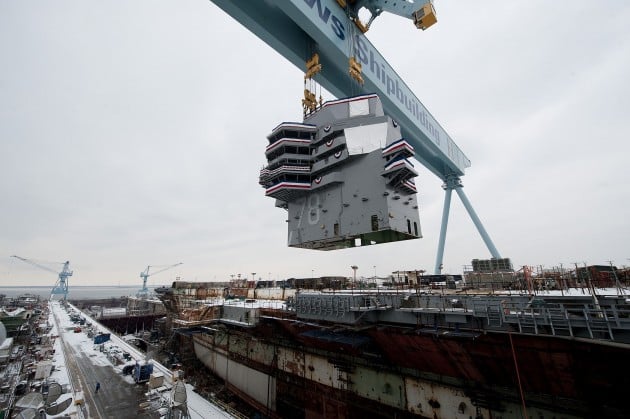
The nuclear carrier USS Ford (CVN-78) under construction at Newport News Shipbuilding.
WASHINGTON: Of the four armed services, the Navy seems set for the smoothest sailing under Donald Trump. The President-Elect’s pro-Russian sentiments cast doubt on the US Army’s main mission, even as he seeks to swell the service’s ranks. His personal intervention in programs like Air Force One and the F-35 has alarmed the Air Force. Even his proposed increase in Marine Corps rifle battalions doesn’t actually match the kind of troops the Commandant wants. But Trump’s three big blessings for the Navy — at least, so far — are entirely unmixed:
[We rolled out our crystal balls for our 2017 forecast. Click to read the whole series.]
- Most obviously, the President-Elect wants to grow the fleet to 350 ships, a whopping 28 percent increase over the current 274. The Navy’s officially said it needs even more ships, 355. Either figure would require a decades-long building campaign. which many in Congress would support.
- More recently, Trump has said “the United States must greatly strengthen and expand its nuclear capability,” even if the price is an “arms race.” While Trump didn’t name the Navy in this context, it’s the Navy that controls most US nuclear forces and whose highest-priority program is a nuclear deterrence platform, the Columbia-class ballistic missile submarine (formerly the Ohio Replacement Program).
- Finally, in contrast to his praise for Putin, Trump has called China “an enemy.” That puts a strategic emphasis on the Pacific. While all four services contribute to security in Asia, the sheer amount of water means the Navy naturally plays the leading role and gets the lion’s share of funding.
The one time the Navy might have gotten caught in the Twitter crossfire, moreover, it came off unscathed. When Trump took aim at Lockheed’s F-35 Joint Strike Fighter, the Navy, Marines, and Air Force all had planes at stake. But the Navy’s F-35C variant is the one being introduced at the slowest pace, so any Trump-induced disruptions to the program will hurt the sea service less than Air Force or Marines.

A Navy F-35C and the plane it will replace, the F/A-18E Super Hornet, sit together on a runway.
What’s more, Trump’s suggested alternative to the F-35, the Boeing F/A-18E/F Super Hornet, happens to a Navy plane. The Marines considered buying Super Hornets but decided not to, instead retaining their aging F-18A/B/C/D Hornets — which have since become a maintenance nightmare — until the arrival of the F-35B, whose jump-jet capabilities are critical to future Marine operations. The Air Force never even considered the Super Hornet and would fight it until their last legislative liaison died from overwork: The F/A-18 would require an all-new maintenance and supply chain, it’s optimized for carrier operations rather than land bases, and it lacks stealth. But the Navy has been buying Super Hornets for two decades, and many admirals would gladly take more, even at the price of delaying the F-35C. And it’s clear the President-Elect will be more than receptive to Navy requests for Super Hornets.
In contrast to his direct intervention in aircraft programs, Trump has stayed silent on specific ships. Except for an off-the-cuff remark that “every time you turn on one of those aircraft carriers, it costs you probably $1 million” — and it’s not clear what he meant by “turn on” — Trump has refrained from remarking on the immense costs of the Navy’s carrier fleet, despite Senate Armed Forces chairman John McCain’s repeated public indignation over cost overruns and schedule slips on the first of the new Ford-class carriers. Nor has Trump criticized the lightweight Littoral Combat Ship, another Navy program much criticized in Congress and the press. A broadside against either warship could have scored Trump easy points for being tough on underperforming programs, much like F-35 and Air Force One, but he refrained.

The two variants of the Navy Littoral Combat Ship — LCS-1 Freedom and LCS-2 Independence – side by side off the California coast.
It’s impossible to say whether Trump held his fire on the Ford and LCS because he didn’t know about their problems, didn’t care, or decided both ships were worth buying anyway. His silence may well end as Congress keeps the pressure on both programs and he feels compelled to chime in as Twitterer-in-Chief. But until Trump changes course — which he’s very capable of doing — his administration is blowing only fair winds for the US Navy.
Navy jet trainer fleet operations remain paused after engine mishap
One week after the incident, a Navy spokesperson says the service is continuing to assess the fleet’s ability to safely resume flight.


























